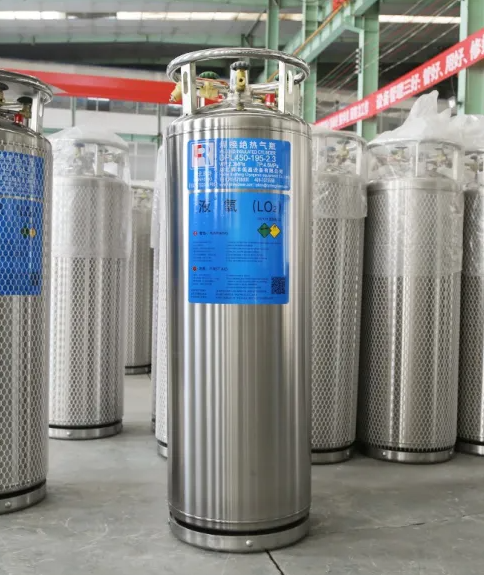How does a CO2 dewar tank work?
Introduction
In our modern world, the storage and transportation of gases are integral to a wide range of industries, from healthcare and manufacturing to food and beverage. One critical component in the safe and efficient handling of gases like carbon dioxide (CO2) is the dewar tank. These tanks are specifically designed to store and transport gases at extremely low temperatures and high pressures. In this article, we will delve into the workings of a CO2 dewar tank, exploring its design, functionality, and various applications.
Understanding the Basics of a CO2 Dewar Tank
A CO2 dewar tank, also known as a cryogenic storage tank, is a specialized vessel designed to store and transport carbon dioxide gas in its liquid form. The key to its operation lies in the principle of cryogenics, which involves the manipulation of gases at extremely low temperatures, typically below -150 degrees Celsius (-238 degrees Fahrenheit), at which most gases become liquids.
The Components of a CO2 Dewar Tank
Inner Vessel: The innermost component of a CO2 dewar tank is the inner vessel, which is typically made of stainless steel. This vessel serves as the primary container for storing the liquid CO2 at ultra-low temperatures. It is designed to withstand the extreme conditions required for cryogenic storage.
Insulation: Surrounding the inner vessel is a layer of high-quality insulation. This insulation helps maintain the low temperature inside the tank by minimizing heat transfer from the surrounding environment. Common insulation materials include vacuum-sealed multi-layered insulation and perlite.
Outer Jacket: The outer jacket is a protective layer that encases the insulation and adds an extra level of structural integrity to the dewar tank. It is usually constructed from materials like carbon steel and provides additional protection against external elements.
Pressure Control System: To maintain the CO2 in its liquid state, a pressure control system is essential. This system regulates the pressure inside the tank, ensuring that the CO2 remains in the liquid phase. It typically consists of safety valves, pressure relief devices, and a pressure gauge.
How Does a CO2 Dewar Tank Work?
The operation of a CO2 dewar tank involves several key steps:
Filling the Tank: Liquid CO2 is loaded into the inner vessel of the dewar tank. The tank is designed to withstand the extreme cold and pressure associated with cryogenic storage.
Insulation: The high-quality insulation surrounding the inner vessel helps minimize heat transfer into the tank. This insulation is crucial to maintaining the extremely low temperatures required to keep the CO2 in its liquid state.
Pressure Control: The pressure control system monitors and regulates the pressure inside the tank. It ensures that the pressure remains within a safe range, preventing over-pressurization or depressurization, which could lead to leaks or other safety hazards.
Transport and Storage: CO2 dewar tanks are designed for both storage and transportation. They are equipped with sturdy handles or lifting points, making them easy to move and position as needed. This versatility is valuable in various industries, such as healthcare, where liquid CO2 is used for cryopreservation, or in the food and beverage industry for carbonation.
Applications of CO2 Dewar Tanks
CO2 dewar tanks find applications in a wide range of industries due to their ability to store and transport carbon dioxide in its liquid state. Some common applications include:
Medical and Healthcare: In the medical field, liquid CO2 is used for cryopreservation of biological samples, including sperm, eggs, and embryos. Dewar tanks play a crucial role in ensuring the safe storage of these precious materials.
Food and Beverage: In the food and beverage industry, liquid CO2 is employed for carbonation, creating carbonated beverages like soda and sparkling water. Dewar tanks are used to transport and store the liquid CO2, ensuring it remains in its liquid form until needed.
Manufacturing: CO2 dewar tanks are used in manufacturing processes for tasks such as cooling, inert gas shielding during welding, and as a source of carbonation for various industrial applications.
Scientific Research: In laboratories and research facilities, dewar tanks are used to store and transport liquid CO2 for experiments and specialized applications, such as supercritical fluid extraction.
Welding and Metal Fabrication: Liquid CO2 is utilized as a shielding gas in welding processes. Dewar tanks provide a convenient and reliable source of this gas, ensuring high-quality welds.
Safety Considerations
Safety is paramount when dealing with cryogenic materials like liquid CO2. Here are some important safety considerations for CO2 dewar tanks:
Proper Training: Anyone handling CO2 dewar tanks should receive appropriate training on their safe operation and handling. This includes understanding the equipment, safety procedures, and emergency response protocols.
Ventilation: CO2 can displace oxygen in enclosed spaces, leading to potential asphyxiation. Ensure proper ventilation when working with CO2 in confined areas.
Pressure Relief: Regularly inspect and maintain pressure relief devices to prevent over-pressurization accidents.
Personal Protective Equipment (PPE): Use appropriate PPE, including gloves and face shields, when handling liquid CO2 to protect against cold burns and splashes.
Emergency Response: Establish clear emergency response procedures, including the use of eye wash stations and emergency showers in case of contact with liquid CO2.
Conclusion
CO2 dewar tanks are vital tools in various industries, allowing for the safe storage and transportation of liquid carbon dioxide at cryogenic temperatures. Their robust construction, insulation, and pressure control systems ensure that CO2 remains in its liquid state, enabling a wide range of applications, from medical cryopreservation to carbonation in the food and beverage industry. However, it is crucial to prioritize safety when working with CO2 dewar tanks, as they contain hazardous materials and operate under extreme conditions. Proper training and adherence to safety protocols are essential to ensure the safe and efficient use of these valuable tools.
136
0
0


Comments
All Comments (0)